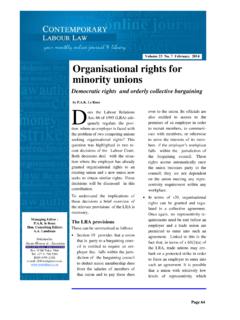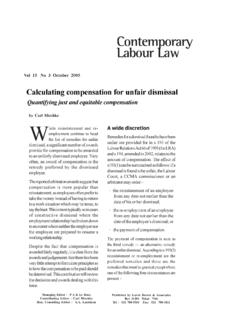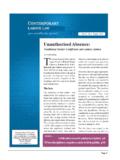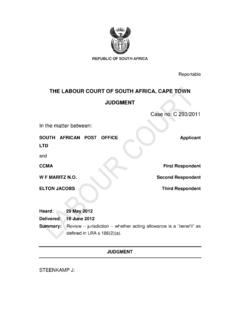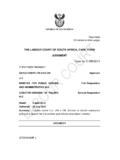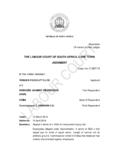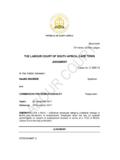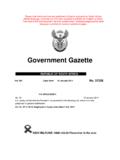Transcription of Volume 24 No. 4 November 2014 Consistency in discipline
1 Page 31 The general approach T he idea that an employer must apply discipline in a consistent fashion is explic-itly provided for in item 7 of the Code of Good Practice: Dismissal and is deeply imbedded in our con-ceptions of fairness as applied in the workplace. Its application in prac-tice has generally been uncontro-versial. The general principle is that an employer must act in a consistent manner ( comply with the parity principle ) when applying discipline . A distinction can be drawn be-tween historical inconsistency and contemporaneous inconsis-tency.
2 The former requires that an em-ployer apply discipline consis-tent with the way in which disci-pline has been applied to other employees in the past. The latter requires that discipline be ap-plied consistently as between two or more employees who commit the same misconduct at the same time. The allegation of inconsistency usually arises in the context of the sanction that has been ap-plied; but it may also arise where the employer has taken discipli-nary action against one em-ployee but not against another employee. It may also possibly arise where one employee has been found guilty of a discipli-nary offence but another has not been found guilty.
3 The most important requirement is that the person with whom the employee is comparing himself must be similarly situated . If an employee alleges inconsistency the employer may be able to show that a distinction can be drawn between the two employ-ees. It is also important that the em-ployer must have known of the Consistency in discipline Managing Editor: le Roux Hon. Consulting Editor: Landman Published by Box 31380 Tokai 7966 Tel: +27 21 788 5560 ISSN-1995-218X e-mail: Volume 24 No. 4 November 2014 by le Roux The territorial jurisdiction of the CCMA p37 The duty to provide safe working conditions p39 A new trend from the Courts?
4 Page 32 misconduct of the comparator. The general approach is summarised in the often-quoted decision of Southern Sun Hotel Interests (Pty) Ltd v CCMA & others (2009) 11 BLLR 1128 (LC) [10 ]A claim of inconsistency (in either histori-cal or contemporaneous terms) must satisfy a subjective element an inconsistency challenge will fail where the employer did not know of the misconduct allegedly committed by the em-ployee used as a comparator (see, for example, Gcwensha v CCMA & others [2006] 3 BLLR 234 (LAC) at paragraphs [37] [38]). The ob-jective element of the test to be applied is a comparator in the form of a similarly circum-stanced employee subjected to different treat-ment, usually in the form of a disciplinary pen-alty less severe than that imposed on the claim-ant (see Shoprite Checkers (Pty) Ltd v CCMA & others [2001] 7 BLLR 840 (LC) at paragraph [3]).
5 Similarity of circumstance is the inevitably most controversial component of this test. An inconsistency challenge will fail where the em-ployer is able to differentiate between employ-ees who have committed similar transgressions on the basis of, inter alia, differences in per-sonal circumstances, the severity of the miscon-duct or on the basis of other material factors. The problems Despite the general acceptance of the parity prin-ciple, it does occasion difficulties for employers. These are some examples - In the case of historical inconsistency, how far back in the past can an employee go to find an alleged example of inconsistency?
6 If the period is too long ago the employer may no longer have the facts or witnesses at its disposal to justify the differentiation When one is dealing with an employer with branches throughout South Africa employing a large number of employees, the practical prob-lems associated with ensuring Consistency are also evident. There is also the problem of a disciplinary chair-man making a decision, usually with regard to sanction but sometimes also with regard to a finding of guilt, which is totally at odds with em-ployer policies or simply not justified by the facts.
7 A decision not to dismiss an employee taken on dubious grounds and in conflict with the provisions of the employer s disciplinary code can lead to allegations of inconsistency in later decisions where the chairperson correctly applies employer policies. Perhaps the most difficult problem arises in the area of the appropriate sanction to be applied. There is a tension between the requirement that discipline must be consistently applied and the requirement that personal circumstances must be taken into account when the issue of sanction is considered.
8 Applying the principle of consis-tency strictly will lead to the argument that a dis-missal was too harsh a sanction because personal circumstances of the employee should have been taken into account. According too much weight to personal circumstances could lead to differing disciplinary sanctions and to allegations of in- Consistency . Finally, there must be unease that an employee who is guilty of a serious disciplinary offence that clearly justifies dismissal should be found to have been unfairly dismissed because of an error made by a chairman of a disciplinary hearing in the past.
9 There are a number of employer strategies that An inconsistency challenge will fail where the employer is able to differentiate between employees who have committed similar trans-gressions on the basis of, inter alia, differences in personal circum-stances, the severity of the misconduct or on the basis of other ma-terial factors. Contemporary Labour Law Vol 24 No 4 November 2014 Southern Sun Hotel Interests (Pty) v CCMA & others Page 33 can be adopted to minimise the above difficulties. For example, if senior management are made aware of a case where the disciplinary chairper-son has come to a decision in conflict with em-ployer policies ( imposed a sanction of a final written warning in circumstances where dismissal would have been the appropriate sanction)
10 , and they are concerned that this decision will be used to argue that subsequent dismissals are unfair be-cause of inconsistency, the employer may be able to reconvene a second disciplinary hearing in or-der to reconsider the matter in accordance with the principle accepted in decisions such as Bran-ford v Metrorail Services (Durban) & others (2003) 24 ILJ 2269 (LAC) and BMW (SA) (Pty) Ltd v Van der Walt (2000) 21 ILJ 113 (LAC). If the case falls outside the relatively narrow con-fines of this principle the employer may be able to rectify the situation by informing employees that this case was, in its view, decided in error and that employees should not see it as a precedent.
